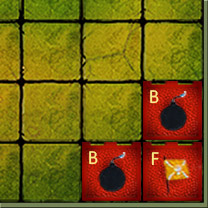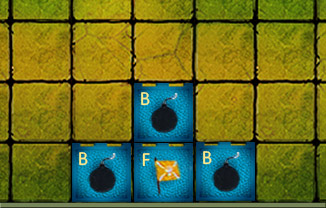
-
Choose different Setups
When you play each game against the same opponent, then alternate your flag location as well as bomb setups, to insure you opponent can't predict where your flag is located.
I often use similar setups as far as bomb locations, but alternate where my flag is located. Once my opponent figures out my bomb formation for certain setups, he has to guess between three different locations for my flag.
-
Use bombs to protect your flag
It is usually a good idea to completely surround your Flag with Bombs. If you do so, and if during the game you are able to capture all of your opponent's Miners, you reduce the number of ways your opponent can win the game in half.
If your Flag is surrounded by Bombs, without Miners, your opponent simply will not be able to capture your Flag.
He must now capture all of your remaining men in order to win.
Below are the two most common methods of surrounding the Flag with Bombs. The first one is in the back row, up against one of the edges of the board. This method uses just two Bombs. The second method is anywhere else in the back row and requires three Bombs.


-
Mix different ranks
It is generally a good idea to not setup same ranked pieces adjacent to each other. You are generally not gaining much by keeping the same ranked piece adjacent to another, since you can only attack by one piece. Also, your opponent's higher ranking piece can easily blow through your formation if they are all the same value.
-
Hide your Spy
Keep the identity of your Spy a secret for as long as you can. If your opponent correctly guesses the location of your Spy, or if your Spy becomes a casualty of war, your opponent's Marshal becomes much more powerful.
-
Save some miners for the endgame
It's usually a good idea to save your Miners for the late stages of the game, after most of your opponent's Bombs have been identified. For this reason, I usually deploy most of my Miners in my back two ranks.
-
Trade off when you have the highest rank
If you have an invincible piece, trade off your lesser valued pieces with equal valued opponent's pieces. (For example, with a invincible Marshall, attack your opponent's Colonel with your Colonel to remove both of them).
This will reduce the number of pieces you have to pay attention to, so you don't go and blow up your invincible piece with a bomb.
-
Spread your Marshal and General
I usually keep my Marshal on one side of the board, and my General on the other. If I kept both of these two officers together, then one side of the board would be quite weak and undefended.
Keeping these two officers apart helps to distribute my resources. My Spy is usually nearby my General, to give him some backup, in case my opponent's Marshal is lurking nearby and desires to give my General some trouble.
-
Check the arrangement
Keep you eyes on the arrangement of your opponent's pieces. After a short period of time, usually you can get a pretty good idea where his Flag and Bombs are, simply by noticing which pieces he has not moved. For this reason you may wish to be sure to not move a few of your pieces, in the hopes that your opponent is keeping an eye on which pieces you don't move.
-
Scout your opponent's high pieces first
At the beginning of the game don't try to capture your opponent's flag if you 'think' you know where it is. Use the early time to find out where his higher ranking pieces are located.
Only later once a lot of your opponent's pieces have been removed can you guess the pattern of his bombs and flag. Only then should you make a serious attempt at capturing his flag.
-
Be careful with your highest pieces
Your Marshal, General, and to a lesser degree your two Colonels are too valuable to lose and therefore should rarely go exploring into enemy territory. These pieces should only attack pieces that a) have already moved and b) you know or strongly suspect are of a lesser rank.
-
Check your Opponent
Pay careful attention to your opponent's reactions to your moves. He will often use his strong pieces to defend the area where his flag is located.
The strength of the Scouts increase near the end of the game, when most of the board is free of pieces and the Scouts can fully utilize their power of rapid movement.
For this reason you may wish to initially place a few of your Scouts in your rear rank.
-
A bluff can win you the game
Sometimes, you can bluff your opponent to get him to move one of his strong pieces away from your territory.
If you know your opponent has not seen one of your weak pieces, and knows that you still have a piece stronger piece than his, use this unknown piece aggressively, as if it is going to attack your opponent's strong piece.
This should at least buy you some time to mount a counter-attack on the other side of the board.
Continue Reading


